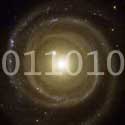|
Wolfram has repeatedly managed to convince
unsuspecting journalists that
his book
"A new kind of science"
(2002)
caused a dramatic
paradigm shift by claiming that the universe and
everything is being computed by a simple program.
Those familiar with the subject, however, know that
the paradigm shift (if any) dates back at least
35 years.
 It was not Wolfram but
Konrad Zuse
who was the first to
suggest that the physical universe is being computed on a
discrete computer, such as a deterministic cellular
automaton (CA). His first
paper on this topic dates back to 1967: Konrad Zuse,
Rechnender Raum, Elektronische Datenverarbeitung,
vol. 8, pages 336-344, 1967.
PDF.
It was not Wolfram but
Konrad Zuse
who was the first to
suggest that the physical universe is being computed on a
discrete computer, such as a deterministic cellular
automaton (CA). His first
paper on this topic dates back to 1967: Konrad Zuse,
Rechnender Raum, Elektronische Datenverarbeitung,
vol. 8, pages 336-344, 1967.
PDF.
Note that this is the same Konrad Zuse who built world's
first working general purpose computers
1935-1941.
Zuse's book on CA-based universes came out 2 years
later:
Rechnender Raum, Schriften zur Datenverarbeitung,
Band 1, Friedrich Vieweg & Sohn, Braunschweig 1969.
English translation: Calculating Space, MIT Technical
Translation AZT-70-164-GEMIT, MIT (Proj. MAC),
Cambridge, Mass. 02139, Feb. 1970.
PDF.
More on Zuse's thesis.
Edward Fredkin (who initiated the MIT translation) later also published
related ideas.
Wolfram grossly
misrepresents Zuse's work, mentioning him in
one single sentence (on page 1026), claiming that Zuse
said that the universe "could be a continuous CA." He
fails to state that Zuse suggested that reality
is in fact computed by a discrete computer or CA, like
those used by Wolfram.
In doing so, he implies that something essential was
missing in Zuse's work. But of course all
the patterns in "A New Kind of Science" could be
reproduced on a Zuse CA.
In fact Wolfram's book adds nothing substantial to Zuse's
ideas, besides the pretty illustrations. Nor does it offer
any predictions that go beyond
Zuse's. Compare both books and judge by yourself.
|
|
On page 486 Wolfram apparently tries to distance himself
a bit from Zuse by writing "that the
universe might not work like a CA ... but instead like
a mobile automaton or Turing machine."
The first paper to suggest this was published five years earlier though:
J. Schmidhuber.
A Computer Scientist's View of
Life, the Universe, and Everything
(in C. Freksa, ed., Lecture Notes in
Computer Science, pp. 201-208, Springer, 1997).
This essay focused on the simplest explanation of
our universe, namely, the very short program that
computes all possible universe histories with all
possible computable laws. The approach is echoed in
Wolfram's chapter 9, section on multiway systems.
The 1997 paper also talks about universes
simulated within parent universes in nested fashion,
and about universal complexity-based measures on
possible universes.
Pointers to follow-up publications
(2000-2002, on universes sampled from computable
probability distributions, and on the fastest way
of computing all universes) can be found
here.
Discussions of this and related work on the everything
mailing list (since 1998) are archived
here.
You will also find many critical and occasionally
quite competent reviews of Wolfram's book
in Edwin Clark's
review page
and among
Amazon.com's
customer reviews.
 Back to intro to computable universes Back to intro to computable universes
|